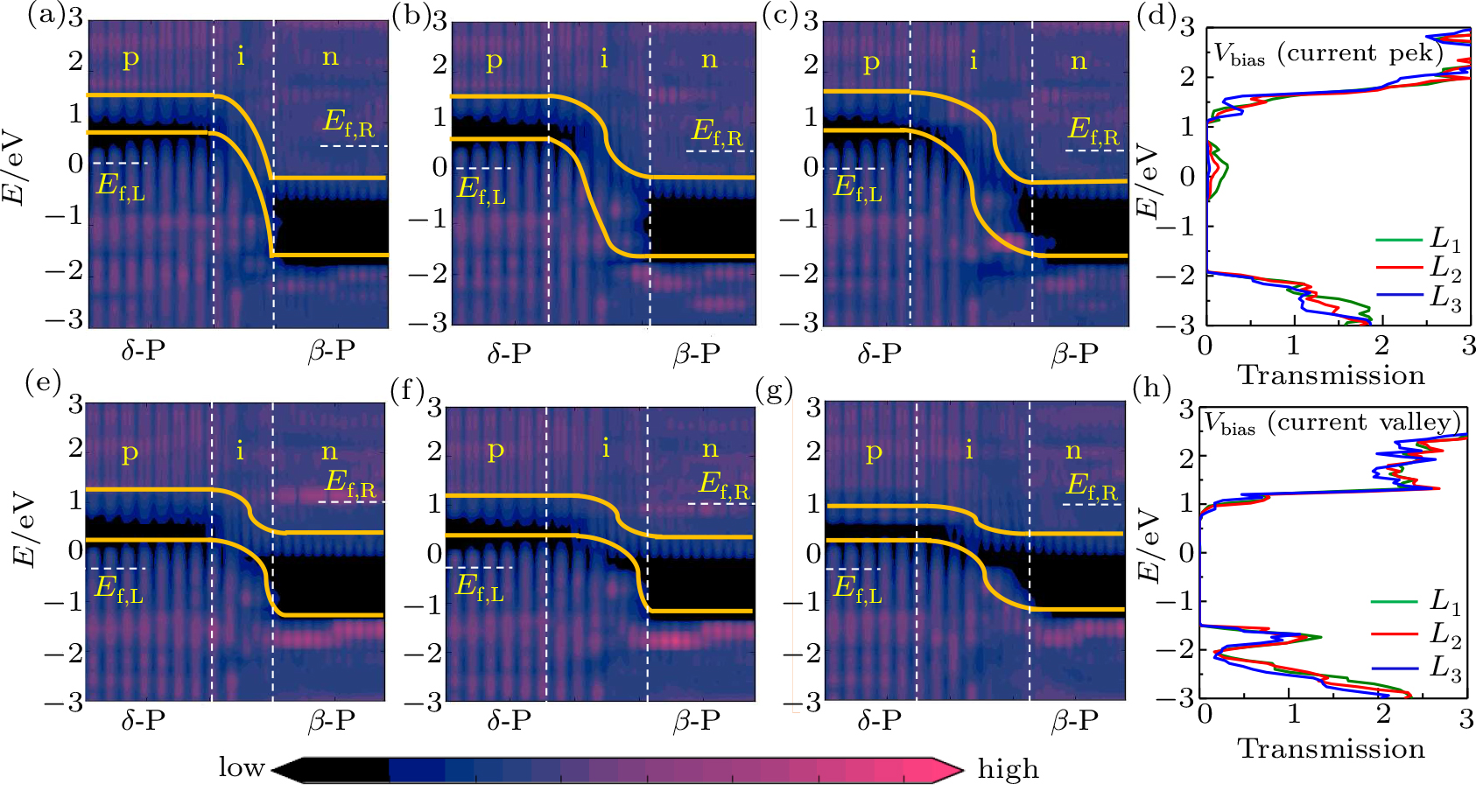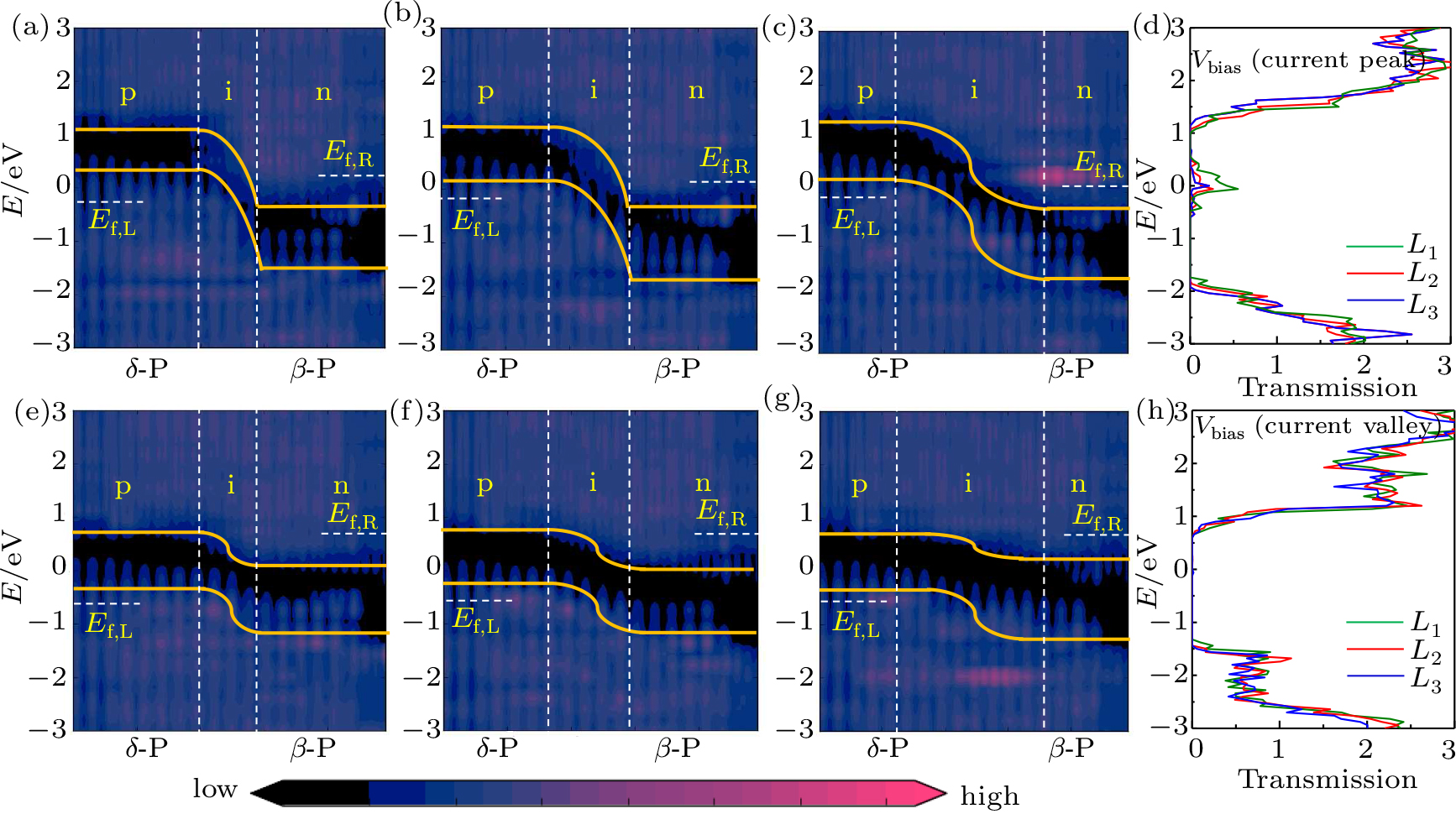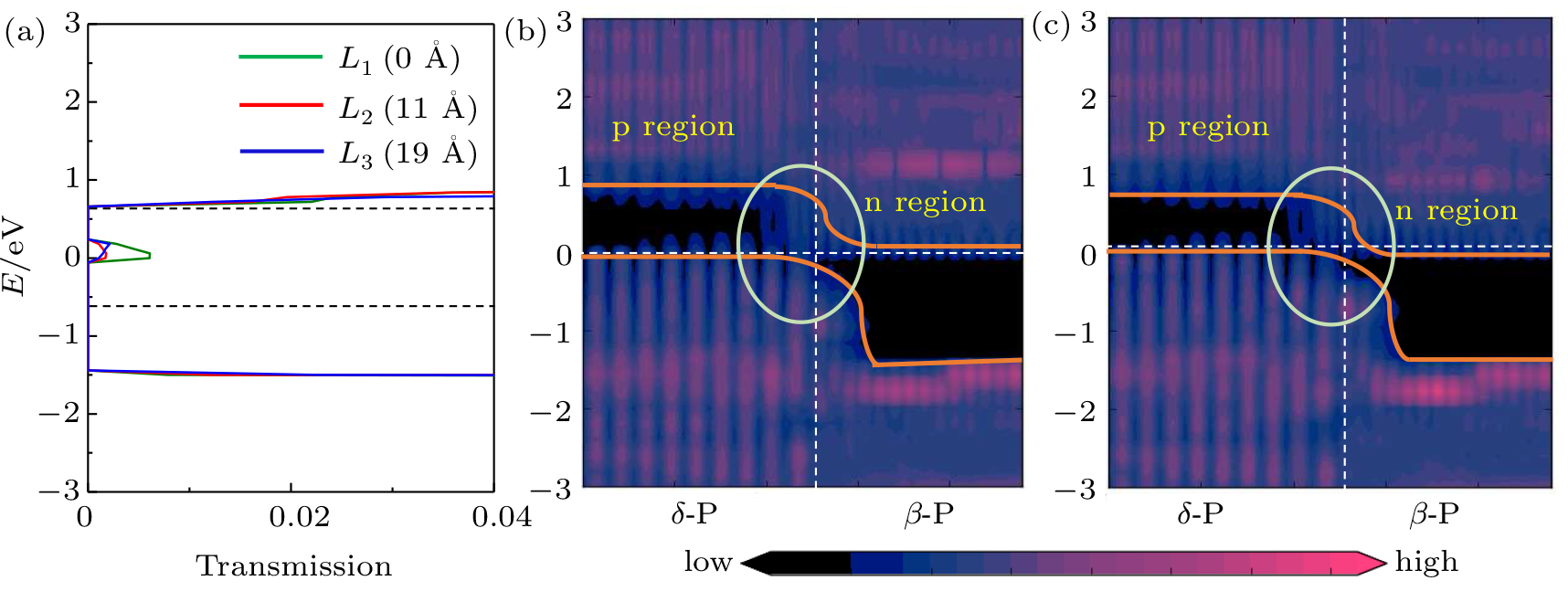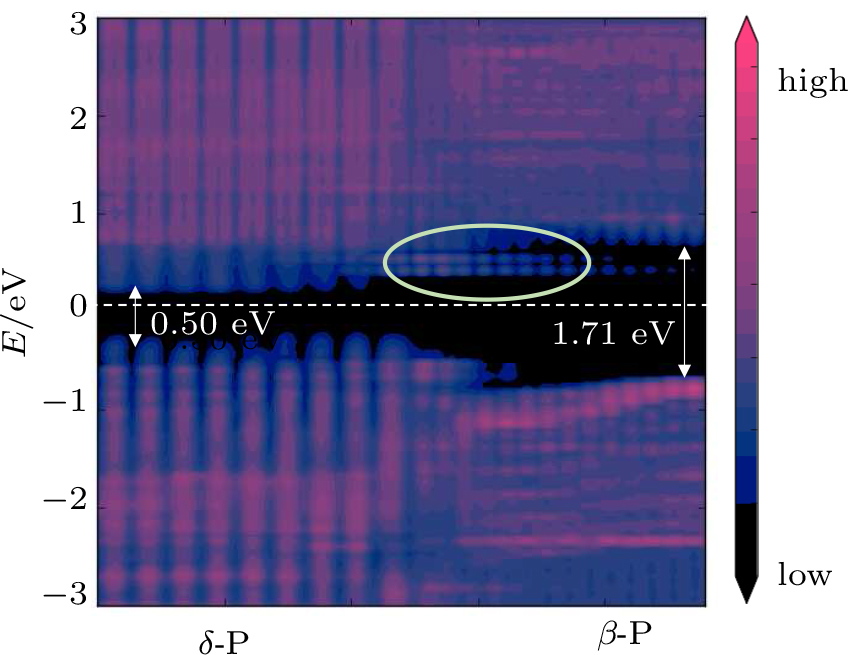† Corresponding author. E-mail:
Project supported by the National Natural Science Foundation of China (Grant Nos. 11604019, 61574020, and 61376018), the Ministry of Science and Technology of China (Grant No. 2016YFA0301300), the Fund of State Key Laboratory of Information Photonics and Optical Communications (Beijing University of Posts and Telecommunications), China, and the Fundamental Research Funds for the Central Universities, China (Grant No. 2016RCGD22).
Tunneling field effect transistors (TFETs) based on two-dimensional materials are promising contenders to the traditional metal oxide semiconductor field effect transistor, mainly due to potential applications in low power devices. Here, we investigate the TFETs based on two different integration types: in-plane and vertical heterostructures composed of two kinds of layered phosphorous (β-P and δ-P) by ab initio quantum transport simulations. NDR effects have been observed in both in-plane and vertical heterostructures, and the effects become significant with the highest peak-to-valley ratio (PVR) when the intrinsic region length is near zero. Compared with the in-plane TFET based on β-P and δ-P, better performance with a higher on/off current ratio of ~ 106 and a steeper subthreshold swing (SS) of ~ 23 mV/dec is achieved in the vertical TFET. Such differences in the NDR effects, on/off current ratio and SS are attributed to the distinct interaction nature of the β-P and δ-P layers in the in-plane and vertical heterostructures.
The metal oxide semiconductor field effect transistor (MOSFET) is the basic building block of modern digital, analog, and memory circuits. However, the power consumption becomes a severe issue with the scaling down of the transistor. Tunneling field effect transistor (TFET) is based on the switching mechanism of band to band tunneling instead of thermionic emission as in the case of MOSFET.[1,2] Therefore, TFET does not suffer from the 60 mV/dec limit of the subthreshold swing (SS), rendering it promising for low-power applications.
TFETs based on bulk semiconductors, such as Si and III–V materials, have been explored for TFETs.[3–7] Especially, the SS of sub-60 mV/dec has been realized in the fabricated Si[8,9] and GeSn quantum well p-channel TFETs.[10] Compared with the conventional bulk semiconductors with the presence of band-tail states, the two-dimensional (2D) semiconductors and related heterostructures with sharp band edges have shown promise to obtain sharp switching in 2D based TFETs. The fabricated 2D WSe2/SnSe2 vertical heterostructure TFET achieves a SS of 100 mV/dec at room temperature over several orders of magnitude of drain current.[11] A record-low minimum SS of 3.9 mV/dec is realized in the atomically thin MoS2 TFET at room temperature.[12] Theoretically, the 2D phosphorene TFETs are predicted to show SS below 60 mV/dec and a wide range of on-current depending on the transport direction due to the highly anisotropic nature of phosphorene.[13]
Besides the potential for low power applications,[14,15] another attractive feature of TFET is the possibility of a novel negative differential resistance (NDR) effect under forward bias voltage, which is caused by the quantum mechanical tunneling of electrons through an ultrathin barrier to provide high current at low voltage.[16] This NDR effect has a good prospect on high frequency switching oscillators and analog-to-digital converters.[17,18]
Recently, 2D van der Waals (vdW) vertical heterostructures, such as graphene/BN/graphene,[19] MoS2/hBN/MoS2,[20] WSe2/SnSe2,[21] MoS2/WSe2,[22] and MoS2/MoSe2[23] have been used to fabricate TFETs. In these TFETs, it is a vdW interaction between the layers in the vertical heterostructures. Apart from the weak vdW interaction, heterostructures can be formed through the strong covalent interaction in the atomic interface between the two materials in the in-plane direction. While the current researches on 2D TFETs are mostly focused on those based on the vdW vertical heterostructures, there are few studies concerning the 2D in-plane TFETs, to the best of our knowledge.
The 2D layered phosphorus, which possesses a few stable structural phases, is attracting increasing attention recently. Among these phases, except for the commonly studied black phosphorus, few layered blue phosphorus (β-P), an in-plane hexagonal isotropic structure, has also been successfully synthesized on Au (111).[24] TFET based on black phosphorus has been studied theoretically.[13] Unlike the isotropic β-P with a sizable band gap of around 2 eV, few layered δ-P is with a narrow band gap of 0.45 eV.[25] Beyond these phases mentioned above, other new monolayer (ML) phosphorus allotropes are also predicted based on ab initio calculations.[26] These different phosphorus phases could coexist by applying certain strain. The coexistence of different structural phases of layered phosphorus with fantastic properties enriches this material family and offers a novel platform for the next generation development of photoelectric devices.
In this paper, we investigate transport properties of the prototype p–i–n TFETs based on in-plane and vertical heterostructures formed by semi-infinite β-P and δ-P layers via ab initio quantum transport simulations. Both the in-plane and vertical tunneling junctions of δ-P and β-P show a significant NDR effect. We discover that different integrations of heterostructures can affect the NDR effect. The PVR of in-plane heterostructures decreases with the increase of the intrinsic region length. However, this phenomenon is not found in vertical heterostructures. In addition, vertical TFET has a higher on/off current ratio of ~ 106 and a steeper SS of ~ 23 mV/dec than the in-plane one, suggesting a greater probability to create an apparent switching effect and reduce operating voltage. Therefore, for heterostructures based on δ-P and β-P, the vertical heterostructure is more suitable for TFET than the in-plane heterostructure, providing new prospects of the phase manipulated layered phosphorus for novel electronics.
The electron transport properties are performed by using density functional theory (DFT)[27] coupled with the nonequilibrium Green’s function (NEGF) method,[28–30] as implemented in the ATK 2015 package. We use the generalized gradient approximation (GGA) in the form of the Perdew–Burke–Ernzerhof (PBE) functional for exchange and correlation potential.[31] To correctly account for the dispersion interaction, we apply the optimized exchange van der Waals functional B86E of the Becke (optB86b vdW) functional.[32] We employ the single-zeta-polarized (SZP) basis set during the device simulations. The k-points of the electrodes (channel) are set to 1 × 18 × 18 (1 × 18 × 6) to make the separation of k-point near ~ 0.01 Å−1 in the Brillouin zone, and the mesh cutoff is set to be 75 Hartree. The temperature is set to 300 K.
The current is calculated by using the Landauer–Buttiker formula[33,34]
 |
To research the transport properties, two kinds of p–i–n junction models based on 5-nm in-plane and vertical heterostructure channels and semi-infinite δ-P and β-P electrodes have been simulated as shown in Fig.
We apply different bias voltages on in-plane and vertical heterostructures, respectively. The I–Vbias curves with different lengths of the intrinsic region of in-plane and vertically stacked heterostructures are depicted in Fig.
The NDR effect can also be understood by comparing the transmission spectra when the current reaches a peak and valley in Figs.
For the vertical heterostructures of δ-P and β-P, we also observe significant NDR effects in the output characteristic in Fig.
The origin of the NDR effect vertical heterostructure is similar to that of in-plane heterostructuresas shown in Fig.
For both in-plane and vertical heterostructures, the transmission eigenstates of the on- and off-state current and the k-points Γ(0,0) are shown in Fig.
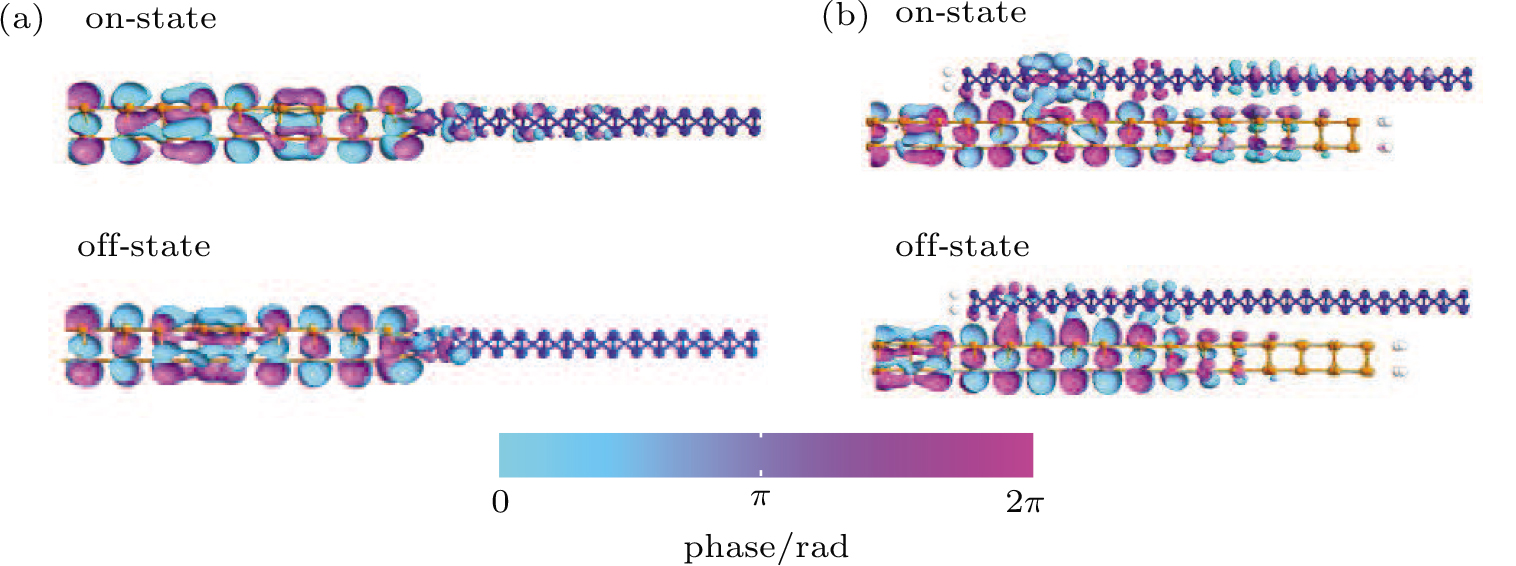 | Fig. 5. (color online) Transmission eigenstate of the current peak and current valley states of the (a) in-plane and (b) vertical heterostructures. Yellow balls: δ-P; blue balls: β-P. |
Comparing the NDR effect of in-plane and vertical heterostructures, we notice that the PVR value of the device with the intrinsic length of 0 Å is the maximum value in both in-plane and vertical heterostructures compared to the other two cases (L2 = 11 Å and L3 = 19 Å), resulting from the narrow intrinsic region. For the vertical heterostructures, PVR of the device with intrinsic lengths of 0 Å and 19 Å are 137 and 56, respectively, which are higher than those of in-plane heterostructures (59 and 11). However, PVR of the device with the intrinsic region length of 11 Å is 45, which is similar to that of in-plane heterostructure (49).
The PVR is determined by the peak current and the valley current. When the intrinsic region length decreases, the peak current and valley current also decrease in both in-plane and vertical heterostructures. When the intrinsic region lengths are 0 Å and 19 Å, the PVRs of vertical heterostructures are higher than those of in-plane ones, because the valley current is similar but the peak currents of the vertical heterostructure are about 4.3 and 4.9 times larger than those of the in-plane heterostructure, respectively. However, when the intrinsic region length is 11 Å, the peak current and valley current of the vertical heterostructure are both around 3 times larger than those of the in-plane heterostructure, so the PVR of in-plane and vertical heterostructures are similar. That is because the valley current of the in-plane heterostructure decreases rapidly from 0 Å to 11 Å relative to the vertical one. We can analyse this phenomenon from the transmission spectrum and LDOS. In the transmission spectrum in Fig.
Because of the inefficient gate control and severe short channel effects with the short channel of 5 nm, we further study a long channel TFET (L = 16 nm). The intrinsic region length is 13 nm in this device. The Ids–Vg curves of in-plane and vertical TFETs are shown in Fig.
For in-plane TFET, the off-state current, which is read at the state where the minimum current appears, is 2.0 × 10−5 μA/μm. Within a supply voltage Vdd = 1.2 V, the on-state is ~ 3 μA/μm and the on/off current ratio is 1.6 × 105. The steepest SS value is 108 mV/dec. Compared with the in-plane one, the vertical TFET shows better performance in both on/off current ratio and SS value. Within a 1.2 V supply voltage, the on/off current ratio of the vertical TFET is about 2.2 × 106, one order of magnitude greater than that of the in-plane one. The steepest SS value is only 23 mV/dec, indicating a much stronger gate control ability in the vertical TFET than that in the in-plane one. Therefore, in terms of the higher on/off current ratio and lower SS value, the vertical TFET has a greater probability to create an apparent switching effect and reduce the operate voltage than the in-plane one.
The reason for the more significant NDR effect, the higher on/off current ratio and steeper SS in the vertical heterostructure than in the in-plane one might be their distinct nature of the interaction between the two materials in the heterostructures. In the vertical heterostructure, the β-P and δ-P are connected by the vdW interaction along the vertical direction. Interlayer vdW interaction will not induce structural disorder and scattering center that affects the charge transport in the vertical heterostructure.[40–42] However, in the in-plane heterostructure, the β-P and δ-P layers are connected by the strong covalent bonds, and a grain boundary forms between the two materials. As shown in Fig.
In summary, we show apparent NDR effects in p–i–n tunneling junction based on β-P and δ-P heterostructures. The PVR value is the highest when the intrinsic region length becomes zero in both in-plane and vertical tunneling junctions. For the vertical heterostructures, the PVRs of the device with intrinsic region lengths of 0 Å and 19 Å are 137 and 56, respectively, which are higher than those in the case of the in-plane heterostructures (59 and 11). However, the PVR of the device with an intrinsic region length of 11 Å is 45, which is similar to that of in-plane heterostructure (49). Moreover, the 16-nm channel vertical TFET exhibits a high on/off current ratio of ~ 106 and a steep SS of ~ 23 mV/dec, which has better performances than in-plane TFET based on β-P and δ-P. These outstanding performances in the TFET based on the vertical heterostructure are related to the relatively high electrical conductivity as the interlayer vdW interaction without inducing a scattering center, in contrast with the formation of the grain boundary in the in-plane heterostructures.
| [1] | |
| [2] | |
| [3] | |
| [4] | |
| [5] | |
| [6] | |
| [7] | |
| [8] | |
| [9] | |
| [10] | |
| [11] | |
| [12] | |
| [13] | |
| [14] | |
| [15] | |
| [16] | |
| [17] | |
| [18] | |
| [19] | |
| [20] | |
| [21] | |
| [22] | |
| [23] | |
| [24] | |
| [25] | |
| [26] | |
| [27] | |
| [28] | |
| [29] | |
| [30] | |
| [31] | |
| [32] | |
| [33] | |
| [34] | |
| [35] | |
| [36] | |
| [37] | |
| [38] | |
| [39] | |
| [40] | |
| [41] | |
| [42] | |
| [43] | |
| [44] | |
| [45] | |
| [46] | |
| [47] |




